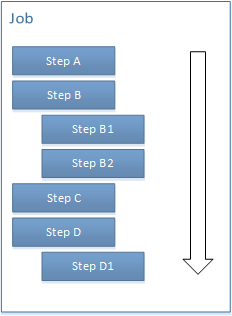The simplest way to run a FlowForce job is to add to it a single step of type "execution step". Such a step can be used to call a FlowForce built-in function, a shell command or script, a MapForce mapping, a StyleVision transformation, a RaptorXML function, and so on.
If you add multiple execution steps to a job, FlowForce will process them sequentially, starting with the first (topmost) step down to the last step. This rule also applies to any sub-steps that a step may have. The diagram below illustrates this scenario.

Sequential processing
By default, if FlowForce encounters an error, processing stops at the step where the error was encountered, and any subsequent steps are not executed.

Sequential processing error
Sometimes, you might not want to break the execution of the whole job if a step fails. In this case, you can configure the function called by the execution step not to stop the job execution. All subsequent steps will then process normally even if a step fails. Note that this behavior can be applied only to steps that call the following functions:
•All functions under /system/filesystem,
•All functions under /system/ftp
•All functions under /system/mail
•The  /system/shell/commandline function.
/system/shell/commandline function.
For more information, refer to the description of each function (specifically, the "Abort on error" parameter).
Sequential processing is just one of the ways to process FlowForce jobs and may not always suit your needs. For more advanced processing, see:
•Processing Steps Conditionally